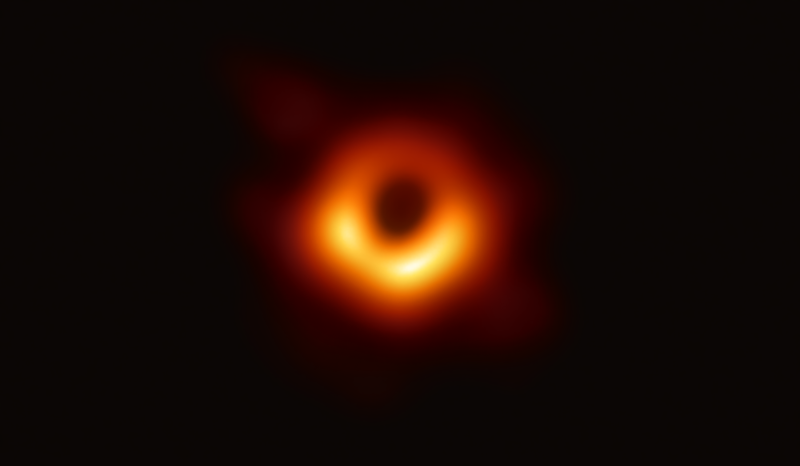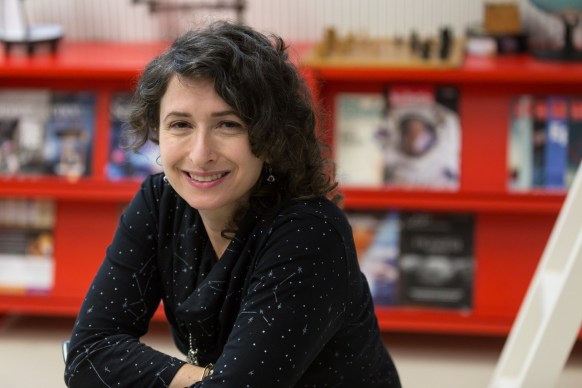
First image of a black hole
Interview with Sera Markoff on the first image of a black hole
On April 10th 2019, the Event Horizon Telescope (EHT) Collaboration presented its first results – an image of the supermassive black hole in galaxy M87 – in multiple simultaneous press conferences around the world, see also here in the APPEC news. Sera Markoff is working on EHT and also on CTA. In this interview she tells us about the exciting times with EHT and the connection to multimessenger astroparticle physics.
Sera, you are enjoying the well-deserved success for the wonderful result on the first image of a black hole in the centre of the M87 galaxy. What is that impressed you most about this success story?

First image of black hole in galaxy M87, credits: Event Horizon Telescope
I think the reaction of the world to our result was not something we had fully anticipated. Gravitational waves were also a ground-breaking result but I don’t think they made it quite so far particularly in social media, because it was maybe a bit too abstract for many members of the public. The image triggered a lot of hilarious posts and memes, which I think is a very positive sign that the world wanted to claim a sort of ownership of the result, and make it relevant to their lives in some way.
What are the next targets and steps?
We still have an enormous amount of data from 2017 and 2018 to analyze, from both the horizon targets (M87 and Sgr A*) as well as many other jetted AGN, some of which were also calibrators for the horizon sources so we have lots of hours on them. These include for instance 3C279, OJ287, and quite a few more. The data analysis and image reconstruction is very tricky particularly for variable sources like Sgr A* so the collaboration are working hard, and one can expect much more science to come. We have also proposed for observations again in 2020, so encourage multi-wavelength facilities to coordinate with us then!
What will be the kind of targets for which you will attempt the reconstruction of the inner jets?
As I mentioned above, these are mostly radio galaxies for obvious reasons, we want sources with well studied jets from other wavelengths particularly with VLBI so we can add another piece at the highest resolution, closest to the core.
You are also working in CTA, hence could you highlight possible connections between the EHT work and the astroparticle community working on multi-messengers high energy astrophysics? What do you expect that can be done in synergy ?
Well EHT is not its own instrument, we use existing facilities during about 10-12 days per year in this special mode. So it’s hard to say whether EHT will exist in its current form when CTA is open for business, but we certainly hope so. We are already adding new elements to the array since 2017, and hopefully will be able to go to higher frequency soon as well. The systems we are studying, with the exception of Sgr A*, all show powerful jets and are high-energy emitters, but we still do not fully understand how these jets are launched, or their internal properties, and there is of course significant debate about the origin of the VHE gamma-ray emitting particles. Where particle acceleration happens exactly, and via which process (e.g., diffusive shock acceleration vs magnetic reconnection) is something one might be able to resolve, if there happened to be a VHE flare during an EHT observation and we could actually resolve associated structural changes in the jet with EHT. I think that is the ‘holy grail’ we would all like to see. We are already observing together with existing VHE facilities like H.E.S.S., MAGIC and Veritas, so this may even happen before CTA and then the work could continue even deeper once we have the much better spatial resolution in the VHE range that CTA offers.
Sera Markoff is a professor of theoretical high energy astrophysics at the University of Amsterdam. Her research focuses on the interface between astrophysics and particle physics, in particular problems relating to processes occurring around dense objects such as black holes. She is a member of a number of large scale research projects including Cherenkov Telescope Array and Event Horizon Telescope, which produced the first image of a black hole. She is a member of the leadership of the Event Horizon Telescope project where she serves as a member of the science council and as one of the working group coordinators.




